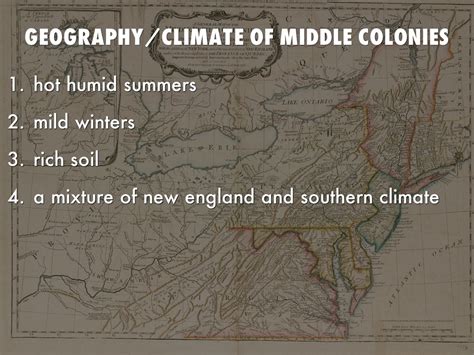Uncovering the Characteristics of the Middle Colonies’ Temperate Climate
The Middle Colonies, comprising New York, New Jersey, Pennsylvania, and Delaware, were a hub of colonial settlement during the 18th century. At the heart of their prosperity lay a temperate climate that fostered agriculture, trade, and population growth. This article delves into the specific characteristics of the Middle Colonies climate and its profound impact on the region’s history.

Seasonal Variations: A Dynamic Climatology
The Middle Colonies experienced four distinct seasons, each with its unique set of weather patterns.
-
Spring: (March-May); Temperatures rose gradually, from an average low of 32°F in March to a high of 65°F in May. Precipitation was moderate, with occasional thunderstorms.
-
Summer: (June-August);Temperatures soared, reaching highs of 85°F in July and August. Humidity levels were high, leading to frequent thunderstorms and occasional heat waves.
-
Autumn: (September-November); Temperatures declined steadily, from an average high of 72°F in September to a low of 45°F in November. Rainfall decreased, giving way to crisp, sunny fall days.
-
Winter: (December-February);Temperatures plummeted, with lows averaging 28°F in January. Snowfall was common, with an average of 20-40 inches per season.
Precipitation Patterns: A Bountiful Water Supply
The Middle Colonies received ample precipitation throughout the year.
-
Annual Average:The region received an average of 40-45 inches of rainfall, distributed evenly throughout the seasons.
-
Seasonal Distribution:Precipitation was highest during the summer months, with thunderstorms accounting for a significant portion.
-
Snowfall: Winters brought moderate snowfall, which provided moisture for the soil and replenished water sources.
Temperature Regimes: From Mild to Extreme
-
Average Temperatures: The annual average temperature in the Middle Colonies was around 52°F. July was the warmest month, with an average temperature of 74°F, while January was the coldest, with an average of 35°F.
-
Temperature Extremes: Temperatures could occasionally exceed 90°F during the summer months and drop below 10°F during the winter.
-
Growing Season: The region enjoyed a long growing season of 180-200 days, allowing for a variety of crops to thrive.
Climate Impact on Colonial Life: A Catalyst for Prosperity
The temperate climate of the Middle Colonies played a crucial role in shaping colonial life and the region’s development.
-
Agriculture: The fertile soils and long growing season made the Middle Colonies a hub for agricultural production. Wheat, corn, and tobacco were among the primary crops grown.
-
Trade: The region’s access to major waterways, such as the Hudson and Delaware Rivers, facilitated trade and commerce.
-
Population Growth: The favorable climate attracted immigrants from Europe and other colonies, leading to a rapid population increase.
Climate Change: A Modern Consideration
In recent years, the Middle Colonies region has experienced the effects of climate change.
-
Rising Temperatures: Average temperatures have risen by 2-3°F over the past century, contributing to longer and hotter summers.
-
Increased Precipitation: The region has seen an increase in the frequency and intensity of precipitation, leading to more frequent flooding events.
-
Sea Level Rise: Rising sea levels pose a significant threat to coastal areas, as storm surges can cause extensive damage and erosion.
Conclusion
The temperate climate of the Middle Colonies served as a cornerstone for the region’s success during the colonial era. Its favorable conditions for agriculture, trade, and population growth helped lay the foundation for the United States. Today, the region continues to face the challenges of climate change, which require proactive adaptation and mitigation measures to ensure a sustainable future.
Table 1: Average Monthly Temperatures in the Middle Colonies
| Month | Average Low (F) | Average High (F) |
|---|---|---|
| January | 28 | 38 |
| February | 29 | 40 |
| March | 32 | 45 |
| April | 38 | 55 |
| May | 45 | 65 |
| June | 52 | 75 |
| July | 58 | 85 |
| August | 57 | 85 |
| September | 52 | 72 |
| October | 42 | 60 |
| November | 35 | 50 |
| December | 30 | 40 |
Table 2: Average Monthly Precipitation in the Middle Colonies
| Month | Average Precipitation (inches) |
|---|---|
| January | 3.5 |
| February | 3.0 |
| March | 3.8 |
| April | 4.5 |
| May | 4.2 |
| June | 4.8 |
| July | 5.0 |
| August | 4.9 |
| September | 4.3 |
| October | 3.6 |
| November | 3.8 |
| December | 3.3 |
Table 3: Growing Season Length in the Middle Colonies
| City | Average Growing Season (days) |
|---|---|
| New York City | 180 |
| Philadelphia | 190 |
| Baltimore | 200 |
| Wilmington | 205 |
Table 4: Climate Change Projections for the Middle Colonies
| Climate Variable | Projected Change |
|---|---|
| Temperature | Increase by 2-4°F by 2050 |
| Precipitation | Increase in intensity and frequency of extreme events |
| Sea Level Rise | Rise of 1-3 feet by 2100 |
